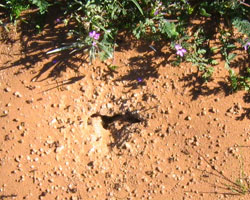Collecting Worker Ants
Although there are some companies that will sell worker ants for your farm, it’s even more fun to collect them yourself from the different kinds of places where ants like to build their homes.
 There are a few key ideas to keep in mind when you go ant-hunting. Some kinds of ants, but not all of them, will sting to defend their colonies from you, so it’s probably best to leave these ants alone. But there are many other kinds of ants that can’t sting at all, which are more pleasant to have around. But you will have to spend some time carefully figuring out what kind of ant you’re watching to see if it’s a stinger or not.
There are a few key ideas to keep in mind when you go ant-hunting. Some kinds of ants, but not all of them, will sting to defend their colonies from you, so it’s probably best to leave these ants alone. But there are many other kinds of ants that can’t sting at all, which are more pleasant to have around. But you will have to spend some time carefully figuring out what kind of ant you’re watching to see if it’s a stinger or not.
Next, one of the most important tricks for collecting your own ants is to collect at the right time of year. In the winter, when it is cold, you probably won’t be able to find very many ants. Why not? Well, probably because ants can’t move very fast in the cold. In the spring and summer, however, ants are usually much more active and will be easier to find. Often, if you give them the right motivation, they might find you before you find them!
Depending on where you live, you might have to do some detective-work to locate an ant colony, and keep in mind that different types of ants like to live in different types of homes: in the soil or in mounds, underneath rocks, or in acorns or pieces of wood. The kinds that are the simplest to find and collect are the ants that are found in the ground.

If you live in an area where ants live in the soil or where ants build mounds, you have a pretty easy job. To find them, just walk around slowly and look for the entrance to a nest. Spend some time trying to find a couple of nests to get an idea of how many different kinds of ants you can choose among. Usually, if you find the entrance and dig up about six inches of soil, you’ll be able to find a lot of worker ants.
If you decide to look for ant nests underneath rocks, all you need to do is carefully flip over a rock that is around the size of a loaf of bread, and check underneath. This method of ant-hunting is kind of like a game of hide-and-go-seek: you won’t find ants underneath every single rock, but it’s really exciting when you do find them. If you look for ants under rocks, please be careful to put the rocks back when you are finished checking for ants. That way, other animals that like to hide out can still use the rocks as a nice hiding place.

Once you have found an ant colony, you can then scoop up some ants with a hand shovel and put them into a clear plastic Tupperware container or glass jar to bring them back with you. The number of ants that you can bring back will depend on how big the colony is and how many you want to collect.
Ants are usually pretty good at climbing, so make sure that your container closes tightly! If you need to transfer them to a new container at any point, it’s okay to knock the container to shake all of the ants to the bottom. They are pretty sturdy and can usually recover quickly.
Read more about: Collecting Ants
Bibliographic details:
- Article: Collecting Worker Ants
- Author(s): Dr. Biology
- Publisher: Arizona State University School of Life Sciences Ask A Biologist
- Site name: ASU - Ask A Biologist
- Date published:
- Date accessed:
- Link: https://askabiologist.asu.edu/collecting-worker-ants
APA Style
Dr. Biology. (). Collecting Worker Ants. ASU - Ask A Biologist. Retrieved from https://askabiologist.asu.edu/collecting-worker-ants
Chicago Manual of Style
Dr. Biology. "Collecting Worker Ants". ASU - Ask A Biologist. . https://askabiologist.asu.edu/collecting-worker-ants
Dr. Biology. "Collecting Worker Ants". ASU - Ask A Biologist. . ASU - Ask A Biologist, Web. https://askabiologist.asu.edu/collecting-worker-ants
MLA 2017 Style
Be Part of
Ask A Biologist
By volunteering, or simply sending us feedback on the site. Scientists, teachers, writers, illustrators, and translators are all important to the program. If you are interested in helping with the website we have a Volunteers page to get the process started.


